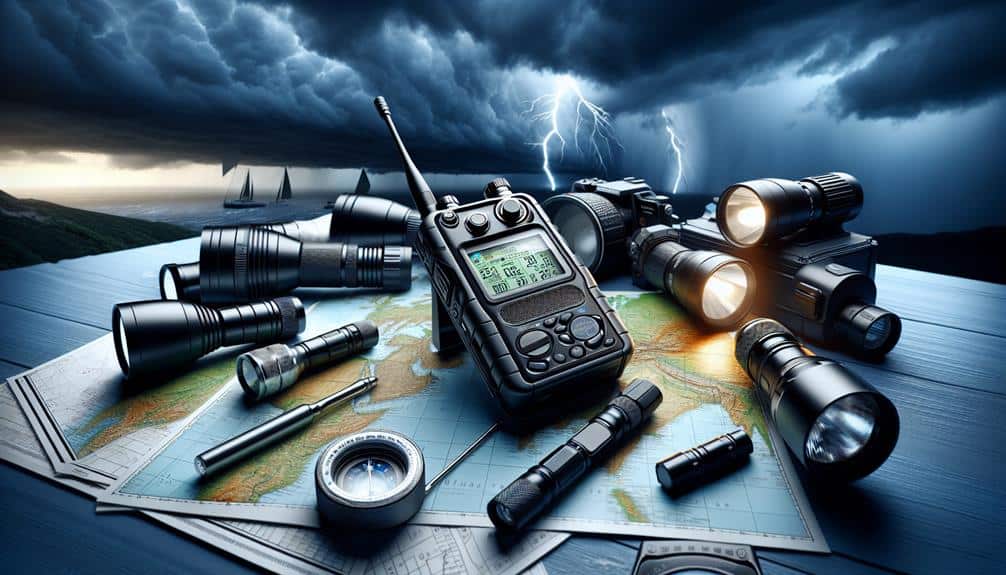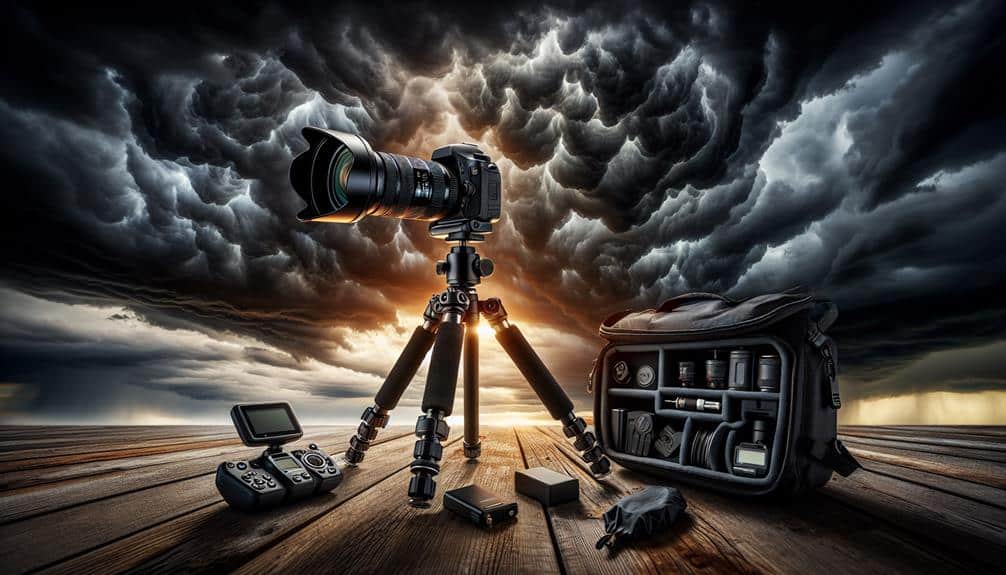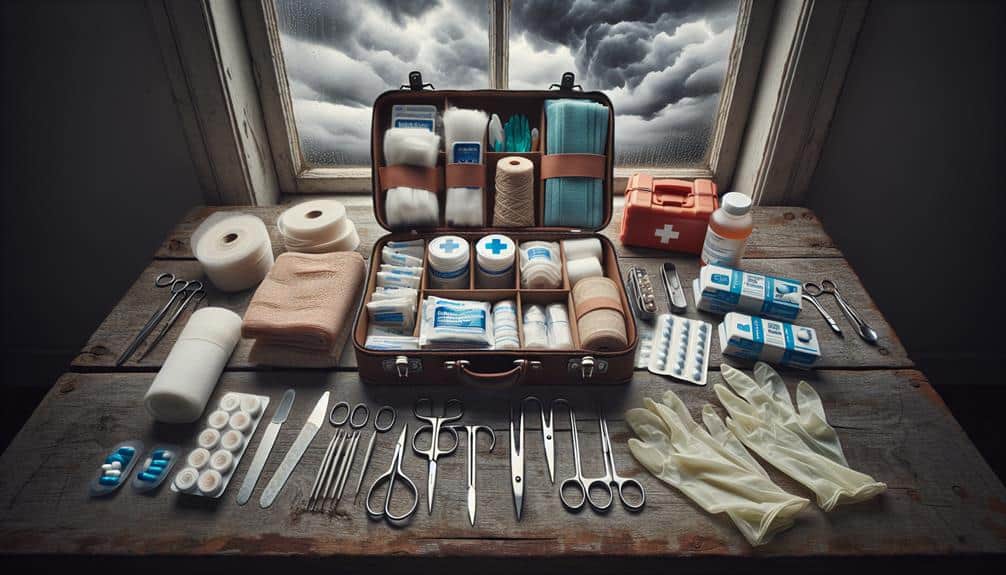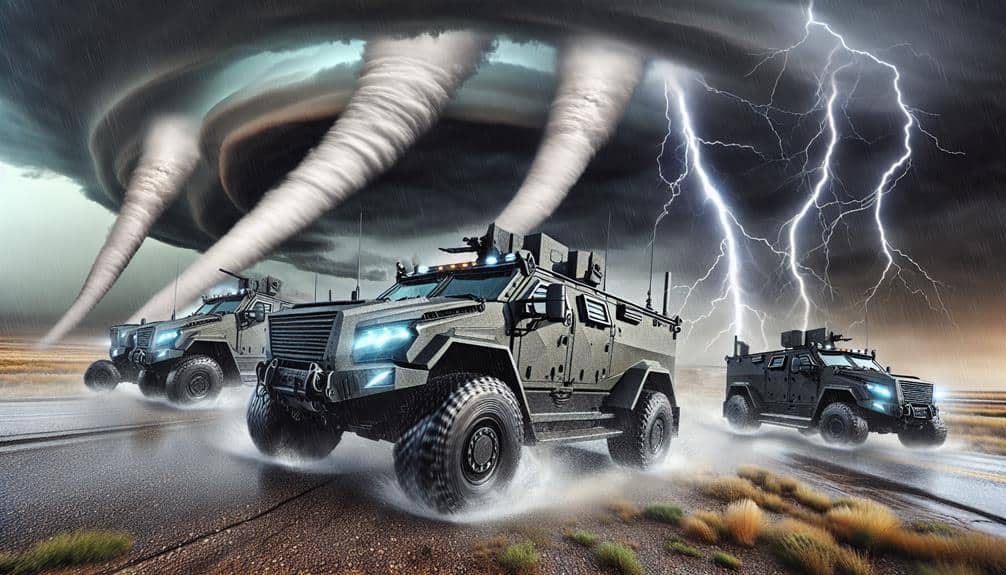As storm chasers, we need a durable 4WD vehicle for all terrains, GPS for real-time navigation, and two-way radios for secure communication in poor signal areas. Thorough weather radios, featuring NOAA channels, guarantee timely alerts. Quality camera gear, including manual settings and sturdy tripods, is essential for documenting storms. Safety gear like helmets, reflective vests, and sturdy boots, paired with a complete emergency vehicle kit, enhances field safety. A first aid kit with bandages, antiseptics, and basic medical supplies is vital. Making sure we have these basics can greatly enhance our storm chasing efficiency and safety, and there's more to think about.
Key Points
- A reliable SUV or truck with 4WD and advanced safety features for navigating rough terrains.
- Dependable GPS navigation and real-time tracking devices for accurate storm monitoring.
- Two-way radios and mobile phones for secure and real-time communication.
- High-quality camera gear with manual settings, tripods, and lightning triggers for precise storm documentation.
Reliable Vehicle
For storm chasing, a reliable vehicle is vital to guarantee both safety and mobility in unpredictable weather conditions. It's essential to choose a vehicle with high durability, all-terrain capabilities, and advanced safety features. The ideal choice would be an SUV or a truck, as these vehicles are designed to handle rough terrains and severe weather scenarios effectively.
We must prioritize vehicles equipped with four-wheel drive (4WD) systems. This ensures better traction on slippery roads and in muddy conditions, which are common during storm chasing. Additionally, a vehicle with a powerful engine can help us quickly maneuver out of dangerous situations, aiding in emergency response.
When it comes to fuel efficiency, a balance is necessary. While we need the power to navigate extreme weather conditions, we also require a vehicle that won't leave us stranded due to frequent refueling. Vehicles with a larger fuel tank capacity provide extended range, reducing the need for frequent stops.
Furthermore, integrating weather-resistant materials and reinforced structures can greatly enhance our vehicle's resilience. Ensuring our vehicle is equipped with essential emergency supplies like first aid kits, fire extinguishers, and basic repair tools is non-negotiable.
This preparation allows us to maintain our freedom and mobility even when facing the most challenging weather conditions.
Communication Devices
When it comes to communication devices, we must prioritize reliability and range. Two-way radios provide us with a secure line of communication even in areas with poor cell coverage, while mobile phones offer convenience and access to real-time weather updates.
Two-Way Radios
Two-way radios, often essential for storm chasers, guarantee dependable communication even in areas with poor cell reception. By using these devices, we make sure a consistent line of contact with our team, which is vital for safety and coordination. Adhering to proper radio etiquette is crucial; clear, concise communication minimizes misunderstandings. We should always have emergency protocols in place, making certain everyone knows how to respond in case a situation escalates.
Range testing is an important preparatory step. Before heading out, we test the radios to determine their effective range under different conditions. This allows us to understand any limitations and plan accordingly. Interference prevention is another significant aspect. We choose frequencies that are less likely to be crowded and keep an ear out for other users to avoid overlapping communications.
When selecting a two-way radio, we prioritize models with long battery life, durable build quality, and sufficient range for our needs. Additionally, weatherproofing is a valuable feature, as it protects the device in harsh conditions. By investing in reliable two-way radios and practicing proper usage, we maintain the freedom to chase storms safely and efficiently.
Mobile Phones
While two-way radios are invaluable, mobile phones offer an additional layer of connectivity through advanced features and broader network coverage. In the domain of storm chasing, having a reliable mobile phone is essential. The ability to access real-time weather updates, GPS navigation, and emergency services makes our mobile phones indispensable tools.
To maximize the effectiveness of our mobile phones, we must consider the significance of network coverage and data plans. Opt for carriers known for robust rural coverage to guarantee we stay connected in remote areas. Unlimited data plans are preferable as they provide continuous access to high-bandwidth applications like radar apps and live streaming.
Signal boosters and accessories can further enhance our mobile phone's performance. Signal boosters amplify weak signals, guaranteeing we maintain connectivity even in fringe areas. Essential accessories include waterproof cases and portable chargers, which safeguard our devices and guarantee they remain operational throughout extended chases.
Ultimately, integrating mobile phones into our storm chasing toolkit equips us with the technological edge to navigate, communicate, and stay informed. By prioritizing network coverage, data plans, and essential accessories, we can elevate our storm chasing experience to new heights of efficiency and safety.
Weather Radios

Let's examine the critical features we need in a weather radio, such as NOAA alerts, battery life, and portability.
We'll also compare the top-rated brands specifically suited for beginners, including Midland and Eton, based on user reviews and expert ratings.
Understanding these elements will help us make informed decisions for our storm chasing activities.
Essential Weather Radio Features
A dependable weather radio must include features such as SAME technology for targeted alerts, NOAA weather channels, and a battery backup to guarantee continuous operation during power outages. SAME technology allows us to receive warnings specific to our chosen areas, reducing irrelevant alerts and making sure we receive vital information promptly. Access to NOAA weather channels is non-negotiable for up-to-the-minute weather updates directly from the source.
Next, antenna range is essential for maintaining strong, clear reception, especially in remote areas where signal strength may be compromised. We need a weather radio with an extendable antenna or external antenna options to maximize range and clarity. This feature ensures we remain informed even in challenging terrains.
Battery life is equally significant. A weather radio should offer long-lasting battery performance, ideally supporting both rechargeable and disposable batteries. This dual-option provides flexibility, allowing us to choose the most convenient power source depending on our situation.
Additionally, some weather radios come with hand-crank or solar charging options, further enhancing their dependability. Making sure our weather radio has these essential features will greatly enhance our storm chasing experience by providing timely, accurate information and robust operational reliability, no matter the conditions.
Best Brands for Beginners
Given the significance of key features in a weather radio, let's explore some of the top brands for beginners that provide reliability, user-friendly designs, and excellent performance.
To achieve the best value, it's crucial to strike a balance between high equipment quality and budget options.
Midland is a leading competitor, renowned for its sturdy equipment quality and user-friendly design. Their WR120 model, priced at approximately $30, includes SAME technology for localized alerts and various power options, making it perfect for beginners.
Next, we've the NOAA-approved Sangean brand, which delivers outstanding performance. The Sangean CL-100, available for around $70, showcases an intuitive interface and clear voice alerts, ensuring we remain well-informed effortlessly.
For individuals with limited budgets, the RunningSnail MD-090 presents a cost-efficient solution at about $25. Despite its lower cost, it doesn't compromise on crucial features like multiple charging methods and NOAA alerts.
Lastly, the versatile Eton FRX5-BT, priced at roughly $80, offers Bluetooth connectivity and a durable design, catering to those who appreciate both functionality and resilience.
In storm chasing, reliable GPS navigation is essential for tracking storm movements and ensuring safety. We can't emphasize enough how important it's to have a dependable navigation system for both storm tracking and emergency preparedness. Technology advancements in GPS devices have greatly improved their accuracy and reliability, making them indispensable tools in storm chasing.
Modern GPS units offer real-time updates, which are vital when we're following rapidly changing weather conditions. These devices provide precise coordinates, allowing us to position ourselves ideally for observing storms while avoiding danger zones. Many GPS systems integrate seamlessly with mobile apps, offering additional layers of data, such as radar overlays and storm path predictions.
Moreover, advanced GPS devices often come with features like traffic updates and alternate route suggestions, which are invaluable when we need to make quick decisions on the road. This level of functionality not only aids in storm tracking but also enhances our overall emergency preparedness.
In our pursuit of freedom and the thrill of storm chasing, investing in a high-quality GPS navigation system is non-negotiable. The right technology can make the difference between a successful chase and a potentially risky situation.
Camera Gear

When it comes to capturing the raw power and beauty of storms, high-quality camera gear is essential for documenting our chases with precision and clarity.
First, a DSLR or mirrorless camera with manual settings is necessary. These cameras offer the flexibility to adjust shutter speed, aperture, and ISO, which is important for shooting in varying lighting conditions. Pairing this with a sturdy tripod ensures stability, especially in windy environments.
Lens filters, such as UV and polarizing filters, help manage light reflections and enhance contrast, making storm clouds more dramatic.
For those breathtaking lightning shots, a lightning trigger accessory is crucial. This device detects lightning and automatically triggers the camera, allowing us to capture the exact moment of a strike.
We must also consider a range of lenses. A wide-angle lens captures the full scope of the storm, while a telephoto lens lets us zoom in on distant formations. Accessories like extra batteries and memory cards ensure we don't miss significant moments due to technical limitations.
Safety Gear
Ensuring our safety during storm chasing requires a complete set of specialized gear designed to protect us from unpredictable weather conditions. Essential safety equipment includes durable helmets and protective eyewear to shield us from flying debris. Reflective vests are important for visibility, especially when traveling in low-light conditions or near busy roads. Additionally, sturdy boots with good traction are necessary for stability on wet or uneven surfaces.
Communication devices, such as two-way radios, guarantee we can reach our team members and emergency services if cell signals fail. A reliable weather radio is essential for real-time updates on storm developments. We should also have a GPS unit to track our position accurately and avoid getting lost in remote areas.
Emergency procedures demand that we carry a complete vehicle emergency kit. This kit should include tools for quick repairs, jumper cables, and emergency flares. It's crucial to have a fire extinguisher readily accessible in the vehicle.
Moreover, we must establish a pre-chase safety plan, detailing evacuation routes and meeting points.
First Aid Kit

Carrying a well-stocked first aid kit is essential for addressing injuries and medical emergencies that may arise during storm chasing. When we're out in the field, the unpredictable nature of storms makes it important to be prepared for any situation. A thorough first aid kit guarantees that we can handle minor injuries and stabilize more serious conditions until professional help arrives.
Key items to include in our first aid kit are:
- Bandages and dressings: These are essential for treating cuts and abrasions, which are common when moving through debris.
- Antiseptic wipes and ointments: These help prevent infections, a vital step when dealing with open wounds in potentially contaminated environments.
Equipping ourselves with emergency supplies isn't enough; we need to complement it with basic medical training. Knowing how to use each item in our first aid kit can make the difference between a quick recovery and a worsening condition.
Frequently Asked Questions
How Do I Join a Storm Chasing Community or Group?
To join a storm chasing community, we should look for groups online that emphasize safety protocols and offer networking opportunities. Participating in forums, attending meteorological events, and connecting through social media are effective strategies.
What Are the Best Times of Year to Chase Storms?
Timing is everything in storm chasing. Spring and early summer offer prime conditions, especially in Tornado Alley. To maximize storm chasing safety, we should target these periods and the best storm chasing locations for best experiences.
Do I Need Any Special Permits to Chase Storms?
For the Current Question, we don't need special permits to chase storms, but we must follow safety precautions. Local regulations vary, so it's important to check permit requirements for each region to guarantee compliance and safety.
How Do I Stay Informed About Severe Weather Forecasts?
While we yearn for the excitement of storm chasing, we must stay informed with weather apps and alerts. It's crucial to keep emergency kits and radios ready. Data-driven decisions guarantee our safety and maximize our freedom to explore.
What Kind of Training or Courses Should I Consider Before Storm Chasing?
We should consider meteorology courses and emergency management training. These provide crucial safety precautions, enhance our understanding of weather patterns, and guarantee we use equipment essentials effectively, maximizing both our freedom and safety during storm chasing.

